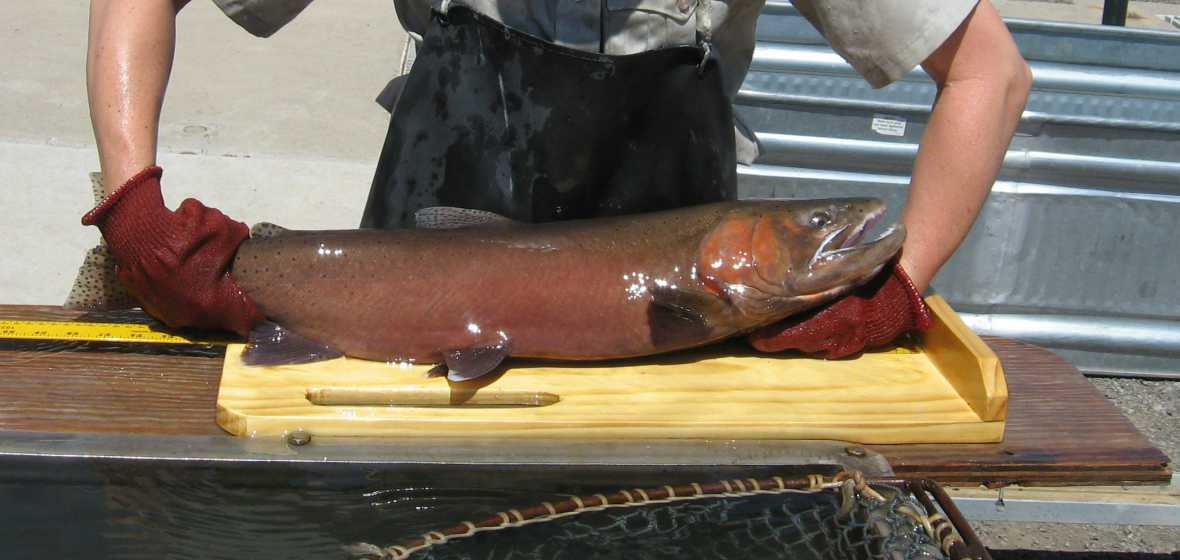The Lahontan cutthroat trout was rediscovered in a "dinky" stream near the Nevada-Utah border. Genetic testing by Associate Professor of Biology Mary Peacock led to the rediscovery of an iconic Nevada fish.
"Even though they were in that tiny, dinky stream on the edge of Utah for close to 100 years, they had maintained that capacity to grow into this big fish," Peacock said. "People just went completely wild; it's like the big boys are back."
Peacock became involved with the research and recovery of the Lahontan cutthroat trout in the early 2000s. She began working on ways to perform genetic testing to determine if the small trout discovered in the Pilot Peak streams were the original species of the Truckee River watershed.
The Peacock lab obtained samples of the Lahontan cutthroat stored in museums and compared the DNA to the Pilot Peak trout.
"We asked a very basic question: ‘Who do these fish look most similar to?'" Peacock said. "We probably had 50 populations in this analysis. So we took those fish, and we compared them to all the populations and did the genetic analysis - and bingo! They're the original dudes."
The recovery of the Lahontan cutthroat trout is a true resurrection story. Weighing in at 40 pounds, with stories of the trout getting up to 60, the Lahontan is the largest species of cutthroat trout. The fish are characterized by their crimson red-orange slash marks on the throat under the jaw with black spots scattered over their steel gray to olive green scales. They are Nevada's state fish and hold a cultural significance to the Pyramid Lake Paiute Tribe.
"Mary Peacock's research and collaboration with the Fish and Wildlife Service over the last 15 years has led to a paradigm shift in how we look at recovery for lacustrine LCT [Lahontan cutthroat trout] in Tahoe and Pyramid Lake," project leader of the Lahontan National Fish Hatchery Complex Lisa Heki said.
Research process
The research to identify the Lahontan began for Peacock in the 1990s, when the U.S. Fish and Wildlife Services hired her to conduct genetic analysis on the Pilot Peak trout. She started out doing a population viability analysis, which is an assessment of the fish and its habitat to determine what factors would lead to a successful survival. Samples were taken from fish in the Pilot Peak streams and were later used for DNA testing.
Since there were no original Lahontan cutthroat trout left in Lake Tahoe, Pyramid Lake or the Truckee River, Peacock and researchers turned to museums for genetic samples of the historic fish.
"Museums are these great repositories of what biodiversity was in the past," Peacock said.
The Smithsonian, Cal Academy and University of Michigan had specimens from the late 1800s through the early 1900s, but they were preserved in a way that made it very difficult to get the DNA out. Peacock's lab manager, Veronica Kirchoff, perfected a technique to get usable DNA out of the museum samples and determined that the Pilot Peak trout was indeed the original Lahontan cutthroat.
"Her work with the museum mounts and her analysis has answered that question for science and for the species, really, and for our recovery efforts," Heki said.
Brief history of the Lahontan cutthroat trout
The building of the Derby Dam in the early 1900s, along with the introduction of invasive species, overharvesting, human water consumption and changing precipitation regimes, began ticking away at the population of the trout, and by the 1940s the fish was extirpated from its native habitat throughout the Truckee River watershed.
In the early 1900s, before Fish and Wildlife Services existed, a wildlife commission took small fish from Pyramid Lake and Lake Tahoe and placed them in streams in eastern Nevada and across the border in Utah. Many of the streams already had populations of fish, but the Pilot Peak streams were fish-less, and the Lahotans survived.
"They took them out on trains and took them in buckets and threw them out everywhere," Peacock said. "So they stuck in this little stream out in the middle of nowhere, and they managed to make it out there and people just forgot about it. It was just happen stance that they got rediscovered."
In the late 1970s, the renowned fish biologist Robert Behnke identified a small fish in the Pilot Peak streams as the Lahontan cutthroat trout. At the time, there were no genetic tools to determine if the fish was the same species. By the 1990s, methods and tools were beginning to develop to determine if the small fish in the Pilot Peak streams were the true offspring of the enormous Lahontan cutthroat trout.
Recovering Nevada's monster fish
U.S. Fish and Wildlife Services stock more than 8,000 Lahontan cutthroat trout in Fallen Leaf Lake, Tahoe Basin, Calif., September 10, 2010. Photo courtesy Jon Myatt/USFWS
In 2006, the U.S. Fish and Wildlife Service, in partnership with the Pyramid Lake Paiute Tribe, stocked the Pilot Peak strain back into its home waters in Pyramid Lake. The fish thrived for several years, growing bigger and bigger. In the early 2000s people began catching 20-pound cutthroats. Today, anglers are catching trout up to 30 pounds. The big monsters have returned.
The fish has returned to its natural migration and reproduction pattern from Pyramid to Tahoe. Recovery efforts going forward will focus on maintaining the habitat of the prehistoric fish that inhabited the area for thousands of years.












